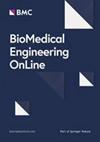Enhancing automated lower limb rehabilitation exercise task recognition through multi-sensor data fusion in tele-rehabilitation
IF 2.9
4区 医学
Q3 ENGINEERING, BIOMEDICAL
引用次数: 0
Abstract
Tele-rehabilitation is the provision of physiotherapy services to individuals in their own homes. Activity recognition plays a crucial role in the realm of automatic tele-rehabilitation. By assessing patient movements, identifying exercises, and providing feedback, these platforms can offer insightful information to clinicians, thereby facilitating an improved plan of care. This study introduces a novel deep learning approach aimed at identifying lower limb rehabilitation exercises. This is achieved through the integration of depth data and pressure heatmaps. We hypothesized that combining pressure heatmaps and depth data could improve the model’s overall performance. In this study, depth videos and body pressure data from an accessible online dataset were used. This dataset comprises data from 30 healthy individuals performing 7 lower limb rehabilitation exercises. To accomplish the classification task, three deep learning models were developed, all based on an established 3D-CNN architecture. The models were designed to classify the depth videos, sequences of pressure data frames, and combination of depth videos and pressure frames. The models’ performance was assessed through leave-one-subject-out and leave-multiple-subjects-out cross-validation methods. Performance metrics, including accuracy, precision, recall, and F1 score, were reported for each model. Our findings indicated that the model trained on the fusion of depth and pressure data showed the highest and most stable performance when compared with models using individual modality inputs. This model could effectively identify the exercises with an accuracy of 95.71%, precision of 95.83%, recall of 95.71%, and an F1 score of 95.74%. Our results highlight the impact of data fusion for accurately classifying lower limb rehabilitation exercises. We showed that our model could capture different aspects of exercise movements using the visual and weight distribution data from the depth camera and pressure mat, respectively. This integration of data provides a better representation of exercise patterns, leading to higher classification performance. Notably, our results indicate the potential application of this model in automatic tele-rehabilitation platforms.通过远程康复中的多传感器数据融合提高下肢康复运动任务的自动识别能力
远程康复是指在个人家中为其提供物理治疗服务。活动识别在自动远程康复领域发挥着至关重要的作用。通过评估患者动作、识别练习和提供反馈,这些平台可以为临床医生提供有见地的信息,从而促进改善护理计划。本研究介绍了一种新颖的深度学习方法,旨在识别下肢康复练习。这是通过整合深度数据和压力热图来实现的。我们假设,结合压力热图和深度数据可以提高模型的整体性能。在这项研究中,我们使用了可访问的在线数据集中的深度视频和体压数据。该数据集由 30 名健康人在进行 7 次下肢康复训练时获得的数据组成。为了完成分类任务,我们开发了三个深度学习模型,它们都基于成熟的 3D-CNN 架构。这些模型旨在对深度视频、压力数据帧序列以及深度视频和压力帧组合进行分类。模型的性能通过 "排除一个对象 "和 "排除多个对象 "的交叉验证方法进行评估。报告了每个模型的性能指标,包括准确率、精确度、召回率和 F1 分数。我们的研究结果表明,与使用单个模态输入的模型相比,在深度和压力数据融合基础上训练的模型表现出最高且最稳定的性能。该模型能有效识别练习,准确率为 95.71%,精确率为 95.83%,召回率为 95.71%,F1 分数为 95.74%。我们的结果凸显了数据融合对准确分类下肢康复训练的影响。我们的研究表明,我们的模型可以利用深度摄像头和压力垫分别提供的视觉和重量分布数据,捕捉运动动作的不同方面。这种数据融合能更好地呈现运动模式,从而提高分类性能。值得注意的是,我们的研究结果表明了该模型在自动远程康复平台中的潜在应用。
本文章由计算机程序翻译,如有差异,请以英文原文为准。
求助全文
约1分钟内获得全文
求助全文
来源期刊

BioMedical Engineering OnLine
工程技术-工程:生物医学
CiteScore
6.70
自引率
2.60%
发文量
79
审稿时长
1 months
期刊介绍:
BioMedical Engineering OnLine is an open access, peer-reviewed journal that is dedicated to publishing research in all areas of biomedical engineering.
BioMedical Engineering OnLine is aimed at readers and authors throughout the world, with an interest in using tools of the physical and data sciences and techniques in engineering to understand and solve problems in the biological and medical sciences. Topical areas include, but are not limited to:
Bioinformatics-
Bioinstrumentation-
Biomechanics-
Biomedical Devices & Instrumentation-
Biomedical Signal Processing-
Healthcare Information Systems-
Human Dynamics-
Neural Engineering-
Rehabilitation Engineering-
Biomaterials-
Biomedical Imaging & Image Processing-
BioMEMS and On-Chip Devices-
Bio-Micro/Nano Technologies-
Biomolecular Engineering-
Biosensors-
Cardiovascular Systems Engineering-
Cellular Engineering-
Clinical Engineering-
Computational Biology-
Drug Delivery Technologies-
Modeling Methodologies-
Nanomaterials and Nanotechnology in Biomedicine-
Respiratory Systems Engineering-
Robotics in Medicine-
Systems and Synthetic Biology-
Systems Biology-
Telemedicine/Smartphone Applications in Medicine-
Therapeutic Systems, Devices and Technologies-
Tissue Engineering
 求助内容:
求助内容: 应助结果提醒方式:
应助结果提醒方式:


